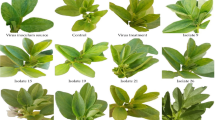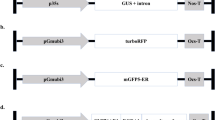Abstract
Transgenic tobacco (Nicotiana tabacum L.) plants with an artificial gene from the antimicrobial peptide bombinin (bom) have been obtained and studied. The presence of the bom gene in the genome of kanamycin-resistant plants was shown by PCR. Expression of the bom gene was confirmed by antimicrobial activity measurements in leaf extracts. The obtained plants were morphogenetically resistant to Erwinia carotovora bacteria and Rhizoctonia solani fungi phytopathogens. In addition, the protective oxidative reaction to the infection, i.e., the SOD activity and proline content, were lower in transgenic plants than in the infected nontransgenic plants. Plants with the expression of the antimicrobial bombinin peptide gene are promising for use in agricultural biotechnology as plant protectors.





Similar content being viewed by others

REFERENCES
Boman, H., Peptide antibiotics and their role in innate immunity, Annu. Rev. Immunol., 1995, vol. 13, pp. 61–92. doi 10.1146/annurev.iy.13.040195.000425
Motesinos, E., Antimicrobial peptides and plant disease control, FEMS Microbiol. Lett., 2007, vol. 270, pp. 1–11. doi 10.1111/j.1574-6968.2007.00683.x
Hyltmark, D., Enqstrom, A., Bennich, H., et al., Insect immunity: isolation and structure of cecropin d and four minor antibacterial components from Cecropia pupae, Eur. J. Biochem., 1982, vol. 127, pp. 207–217. doi 10.1111/j.1432-1033.1982.tb06857.x
Mills, D. and Hammerschlag, F.A., Effect of cecropin B on peach pathogen, protoplasts, and cells, Plant Sci., 1993, vol. 93, pp. 143–150. doi 10.1016/0168-9452(93)90043-Y
Rukavtsova, E.B., Bur’yanov, Ya.I., Shul’ga, N.Ya., and Bykov, V.A., Transgenic plants for pharmacology, Vopr. Biol. Med. Farm. Khim., 2006, no. 2, pp. 3–12.
Russel, C. and Clarke, L., Recombinant proteins for genetic disease, Clin. Genet., 1999, vol. 55, pp. 389–394.
Martemyanov, K.A., Spirin, A.S., and Gudkov, A.T., Synthesis, cloning and expression of genes for antibacterial peptides: cecropin, magainin, and bombinin, Biotechnol. Lett., 1996, vol. 18, pp. 1357–1362. doi 10.1007/BF00129335
Simmaco, M., Barra, D., Chiarini, F., et al., A family of bombinin-related peptides from the skin of Bombina variegate, Eur. J. Biochem., 1991, vol. 199, pp. 217–222. doi 10.1111/j.1432-1033.1991.tb16112.x
Zakharchenko, N.S., Loktyushov, E.V., Rukavtsova, E.B., et al., Obtaining transgenic plants expressing the antimicrobial peptide bombinin gene, Izv. Tul’sk. Gos. Univ.,Ser.: Estestv. Nauki, 2013, no. 3, pp. 287–297.
Murashige, T. and Skoog, F., A revised medium for rapid growth and bioassays with tobacco cultures, Physiol. Plant., 1962, vol. 15, no. 3, pp. 473–497. doi 10.1111/j.1399-3054.1962.tb08052.x
Dye, D.M., A taxonomic study of the genus Erwinia the “Carotovora” group, N. Z. J. Sci., 1969, vol. 12, pp. 81–97.
Sambrook, J., Fritsch, E.E., and Maniatis, T., Molecular Cloning: A Laboratory Manual, New York: CSHL Press, 1989, pp. 4–1626.
Naumov, N.A., Metody mikologicheskikh i fitopatologicheskikh issledovanii (Methods of Mycological and Phytopathological Research), Leningrad: Sel’khozizdat, 1937, pp. 2–272.
Edwards, K., Johnstone, C., and Thompson, C., A simple and rapid method for the preparation of plant genomic DNA for PCR analysis, Nucleic Acids Res., 1991, vol. 19, p. 1349. doi 10.1093/nar/19.6.1349
Draper, J., Scott, R., and Hamil, J., Transformation of dicotyledonous plant cells using the Ti plasmid of Agrobacterium tumefaciens and the Ri plasmid of A. rhizogenes, in Plant Genetic Transformation and Gene Expression. A Laboratory Manual, Draper, J., Scott, R., Armitage, P., and Walden, R., Eds., Oxford: Blackwell, 1988, pp. 69–160.
Ohshima, M., Mitruhara, I., Okamoto, M., et al., Enhanced resistance to bacterial diseases of transgenic tobacco plants overexpressing sarcotoxin IA, a bactericidal peptide of insect, J. Biochem., 1999, vol. 125, pp. 431–435. doi 10.1093/oxfordjournals.jbchem.a022304
Bradford, M.M., A rapid and sensitive method of the quantitation of microgram quantities of protein utilizing the principle of protein dye binding, Anal. Biochem., 1976, vol. 72, pp. 248–254. doi 10.1016/0003-2697(76)90527-3
Beauchamp, C.O. and Fridovich, I., Superoxide dismutase: improved assays and an assay applicable to acrylamide gels, Anal. Biochem., 1971, vol. 44, pp. 276–287. doi 10.1016/0003-2697(71)90370-8
Uchiyama, M. and Mihara, M., Determination of malonaldehyde precursor in tissue by thiobarbituric acid test, Anal. Biochem., 1978, vol. 86, pp. 287–297. doi 10.1016/0003-2697(78)90342-1
Bates, L.S., Waldren, R.P., and Teare, I.D., Rapid determination of free proline for water-stress studies, Plant Soil, 1977, vol. 39, no. 1, pp. 205–207. doi 10.1007/BF00018060
Revenkova, E.V., Kraev, A.S., and Skryabin, K.G., Construction of disarmed derivative of the supervirulent Ti plasmid oTiBo542, in Plant Biotechnology and Molecular Biology, Skryabin, K.G., Ed., Moscow: Pushchino Research Center, 1993, pp. 67–76.
Mittler, R., Oxidative stress, antioxidants and stress tolerance, Trends Plant Sci., 2002, vol. 7, pp. 405–410. doi 10.1016/S1360-1385(02)02312-9
Mandal, S., Mitra, A., and Mallick, N., Biochemical characterization of oxidative burst during interaction between Solanum lycopersicum and Fusarium oxysporum f. sp. lycopersici, Physiol. Mol. Plant Pathol., 2008, vol. 72, pp. 56–61. doi 10.1016/j.pmpp.2008.04.002
Sharma, P., Jha, A.B., Dubey, R.S., and Pessarakli, M., Reactive oxygen species, oxidative damage, and antioxidative defense mechanism in plants under stressful conditions, J. Bot., 2012, vol. 4, pp. 1–26. doi 10.1155/ 2012/217037
Viljevac, M., Dugalic, K., Stolfa, I., et al., Biochemical basis of apple leaf resistance to Erwinia amylovora infection, Food Technol. Biotechnol., 2009, vol. 47, no. 3, pp. 281–287. oai:hrcak.srce.hr:39845
Kim, M.S., Kim, H.S., Kim, K.H., et al., Expression of lily chloroplastic Cu, Zn superoxide dismutase enhances resistance to Erwinia carotovora in potatoes, J. Plant Pathol., 2007, vol. 23, no. 4, pp. 300–307. doi 10.5423/PPJ.2007.23.4.300
Kuznetsov, V.V. and Shevyakova, N.I., Proline under stress: biological role, metabolism, and regulation, Russ. J. Plant Physiol., 1999, vol. 46, no. 2, pp. 274–288.
ACKNOWLEDGMENTS
The work was financially supported by the Russian Fund for Basic Research, project nos. 15-08-02050 and 16-04-00623.
Author information
Authors and Affiliations
Corresponding author
Additional information
Translated by V. Mittova
Abbreviations: AMPs—antimicrobial peptides; ROS—reactive oxygen species; BSA—bovine serum albumin; PGA—potato glucose agar; MDA—malonic dialdehyde; PAAG—polyacrylamide gel; bp—base pair; POL—peroxide oxidation of lipids; PCR—polymerase chain reaction; SOD—superoxide dismutase; bom—bombinin gene; dNTP—deoxynucleoside triphosphate (s); 35S—35S promoter of cauliflower mosaic virus; SDS—sodium dodecyl sulfate.
Rights and permissions
About this article
Cite this article
Zakharchenko, N.S., Pigoleva, S.V., Furs, O.V. et al. Gene Expression of the Antimicrobial Peptide Bombinin Increases the Resistance of Transgenic Tobacco Plants to Phytopathogens. Appl Biochem Microbiol 54, 730–735 (2018). https://doi.org/10.1134/S0003683818070086
Received:
Accepted:
Published:
Issue Date:
DOI: https://doi.org/10.1134/S0003683818070086



